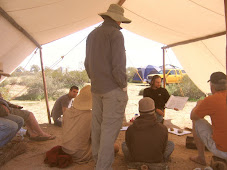Tales of Geronimo's cunning retreats from his military pursuers abound. One story holds that Geronimo and his band disappeared without explanation when trapped in a cave that had no second entrance. On horseback, he and his warriors were able to keep ahead of the U.S. cavalry -- with its horses and loads of supplies -- at a pace of 70 miles a day while carrying very little and living on wild plants and animals, even resorting to killing their own horses for sustenance. During battles, Geronimo was shot and wounded several times yet never succumbed to death from a bullet wound.
In short, the man was -- like most traditional native peoples of his time -- quite a specimen.
 Looking at his photos, Geronimo's beautiful facial structure -- round face, square jaw, prominent cheek bones, wide flaring nostrils -- is readily apparent. This indicates a full and proper development during his formative years as an infant, young boy, and teenager. (We can't comment on his teeth as he never smiled in photos, but he probably had all of them.) His broad shoulders and upright posture suggest agile movement and strength. Like a wild animal, Geronimo was optimally built for his rugged environment of high mountain sky islands and vast seas of low desert. Having lived near, and backpacked through, the Chiricahua Mountains in southeastern Arizona (Geronimo's former stomping grounds) for several months, I can attest to the ruggedness of this landscape.
Looking at his photos, Geronimo's beautiful facial structure -- round face, square jaw, prominent cheek bones, wide flaring nostrils -- is readily apparent. This indicates a full and proper development during his formative years as an infant, young boy, and teenager. (We can't comment on his teeth as he never smiled in photos, but he probably had all of them.) His broad shoulders and upright posture suggest agile movement and strength. Like a wild animal, Geronimo was optimally built for his rugged environment of high mountain sky islands and vast seas of low desert. Having lived near, and backpacked through, the Chiricahua Mountains in southeastern Arizona (Geronimo's former stomping grounds) for several months, I can attest to the ruggedness of this landscape.Lifestyle plays a major role in the fitness levels of Geronimo. Traveling on foot or horseback for up to 70 miles, stalking wild game, and crafting tools and shelters from his surroundings, he spent his life using his body. This lifetime "use" was certainly a major contributing factor to his physical capabilities. Yet, perhaps he wouldn't have been as capable -- his body not as supported, his build not as solid, his immunity and ability to recover from bullet wounds diminished -- if he hadn't also eaten the natural, primitive diet of his people. What kind of diet was that? Here's a list of some of the staple foods that the Apaches ate and the nutritional qualities that make them supportive:
- Wild game: deer, elk, quail, rabbit, etc. --> utilizable proteins and fats, which provide amino acids, b-vitamins, fat-soluble vitamins, and, when using the whole animal (as was common in Geronimo's day), every single needed nutrient the human body needs. (Interstingly, the Apaches had taboos against eating snakes, frogs, fish, and bears.)
- Corn, beans, and squash--> starchy carbohydrates traditionally processed to eliminate anti-nutrients (fermented, roasted, soaked, leached, etc.) providing supplemental energy and sparing fat loss; additional vitamins and minerals (for an interesting account of how Apaches prepared a fermented corn drink called tizwin, see bottom of this post)
- Agave--> heart of the plant pit-roasted, young stalks eaten; provides supplemental starch and sugars in the diet; spares fat loss ... but gives horrible gas (I can attest to this myself after eating a pit-roasted agave -- yeesh!)
- Acorns & Pine nuts--> roasted, soaked, leached, pounded, or eaten fresh (some species); beneficial proteins and fats; particularly rich in monounsaturated fatty acids
- Prickly Pear Cactus--> fruit cooked into syrup or eaten fresh and young pads boiled or roasted (high in oxalic acid raw); fruits rich in electrolytes for a hot, dry climate; pads rich in calcium and vitamin A beta-carotene
So, it seems that the famous Apache leader lived healthfully with vigor and "fierceness" (as many accounts report) throughout his life. But what of his lifespan? Does it fit the description, "nasty, brutish, and short?" Not in the least. Geronimo lived from 1829-1909, dying at age 79 from pneumonia after drunkenly falling off his horse and contracting a severe cold. Had his life not been cut short by this accident, perhaps he would have lived well into his 80s or 90s.
"I cannot think that we are useless or God would not have created us. There is one God looking down on us all. We are all the children of one God. The sun, the darkness, the winds are all listening to what we have to say."
Making "Tiznin" -- An Apache Fermented Corn Drink
"First, they soaked the corn overnight in water. They dug a long trench and lined it with grass, placed the soaked corn in the trench, and covered it with another layer of grass. Sometimes they covered the whole with earth or a blanket. After sprinkling the corn with water morning and evening for ten days, during which it sprouted, they took it out, ground it with their grinding stones (mano and metate), and then boiled it for five hours. Finally, they strained off the liquid and set it aside. After about twenty-four hours, when it stopped bubbling, it was ready to drink." (From Geronimo: The Man, His Time, His Place by Angie Debo, p. 22)
by Angie Debo, p. 22)




